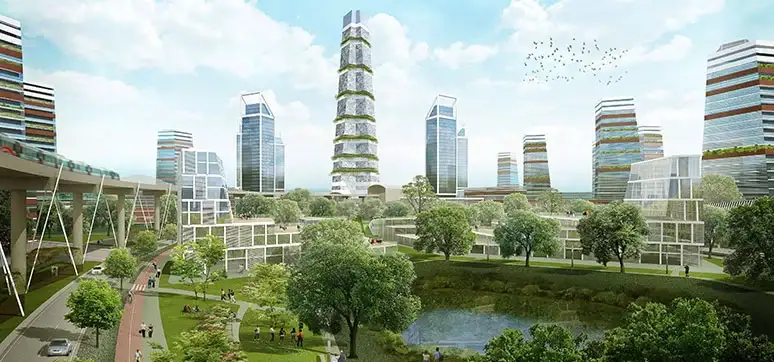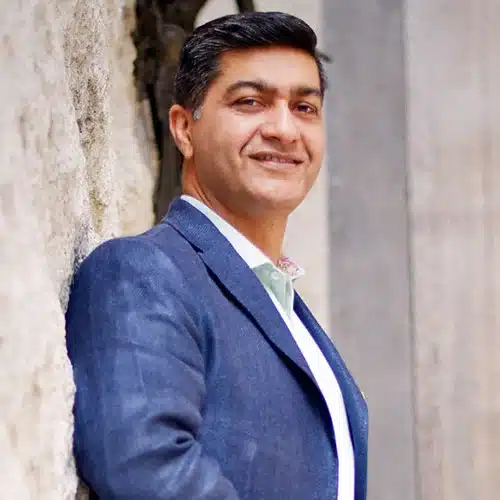Tell us about your practice CPKA and its growth in India?
C P Kukreja’s vision, hard work, imagination, and human values have been the core of our firm and have set the foundation for achieving what we have achieved today. Our team has been consistent in delivering meaningful architecture through significant projects over the last five decades which has not only made a difference in many Indian cities but abroad too. Concepts of eco-friendly design, culturally responsive architecture, and futuristic and innovative ideas have been propagated through the design and construction of numerous projects. Our practice has achieved many successful milestones from delivering the design of one of the largest to the tallest buildings in the country, promising that every project is special in its own way and gives out a significant message about the very idea of ‘architecture’ and its future to the society and beyond.

Over the years, what kind of changes are you seeing in Indian Architecture?
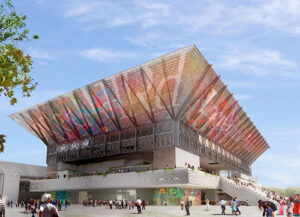
India has a remarkable history of sustainable, vernacular architecture where buildings use passive design, local materials and respond to the site context. It is very difficult to define what “Indian Architecture” really is. To me, the future of Indian architecture is not about imbibing an identity that is only skin deep. It is about architecture that is sensitive to the needs of its context – social, political, economic, and geographic. It is about creating a meaningful dialogue between the tangible and intangible aspects of the built form and giving up superfluity, for a design that has a true impact on its surroundings.
What prompted you to become an architect and choose this as your career?
It has been a dream since as early as I can remember. The vivid memories of going with my parents particularly to monuments in and around Delhi for picnics used to always enthuse me. Though at that time, I did not understand much, yet there was something that connected with me. I was instinctively drawn to buildings.
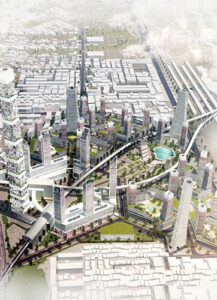
Oriented Development (TOD) in India, being developed at Karkardooma
CPKA has designed many landmark projects around the world. Could you please tell us about your projects in India?
We are humbled to be associated with remarkable projects shaping our country at the moment. One of the highly anticipated projects is the India International Convention Centre at Dwarka, New Delhi which has been envisaged at the scale of a Central Business District (CBD). The state-of-the-art Convention Centre would be Asia’s 2nd largest and the 3rd largest in the world with a capacity to host 10,000 people at once, designed to host mega international events in India like the G20 Summit. With a site area of 225 acres, the project also boasts of a 20,000 seater one-of its- kind, world-class indoor arena with a retractable roof that would be built in India for the first time.
Another project which has our team excited is the East Delhi Hub, conceived as the pilot project for Transit-Oriented Development (TOD) in India, being developed at Karkardooma, New Delhi along with the tallest 100-storeyed tower in the country. The use of ‘organic density’ as a tool for spontaneous adaptation to environmental and economic diversity, and as an auto adjustable controlling measure for the population influx and activities within the urban complex, lies at the crux of this revolutionary vision.
Any building is identified by its façade, hence the clients too are ambitious. There are many kinds of innovative façade materials available in the market, including for cladding/glazing. How do you go about selecting façade material?
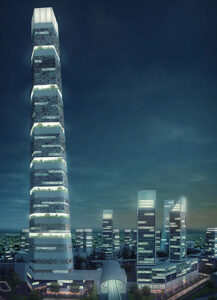
Façade of a building provides the most apparent visual experience that a user or visitor can have of it. Innovation is creating new kinds of façade materials with changing times. There is, in fact, a greater variety today more than one has seen ever before in terms of what architects can incorporate in the facades of their buildings. In terms of selection, our process is a result of multiple factors since façade is one of the most important aspects defining the relationship of the visuals of the building with the viewer. So, the façade selection is based on parameters such as the contextual representation of what the design portrays, choice of availability of local materials, fabrication or manufacturing or modularity of its usage, the persona or character that the façade material needs to demonstrate, and lastly the cost of the material with respect to the overall budget allocated to the project.
Please tell us about your projects abroad?
We recently completed the India Pavilion at the World Expo 2020 Dubai. We are also the architects for HCL’s Vietnam office where the design is conceptualized using biophilic design. The design concept blends innovation in a modern workspace with refined aesthetics and high-end technology that enhances the functionality of space, inspires its users, and initiates a reimagined office model.
India Pavilion at Expo 2020 Dubai
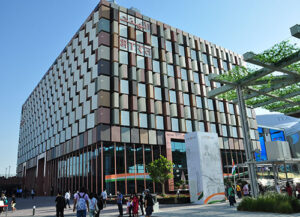
The Expo 2020 Dubai is a global stage for renowned architects from all over the world to represent countries whilst showcasing design finesse. With an overarching theme of ‘Connecting Minds, Creating the Future, it is a platform promoting partnerships for innovation, inclusion, and understanding. The design for the India Pavilion seeks to exhibit the substantial growth the country has witnessed through the years after independence, becoming a land of limitless opportunities even for international investors.
For us, representing India on an international platform at Expo 2020 Dubai meant developing a design for the India Pavilion that creates a meaningful dialogue between the tangible and intangible aspects of the built form. This was a very unique project to work on because it is showcased on a global stage where you have an assortment of architecture from around the world. We felt that the best way to communicate an India on the move, the transformational aspects of the country so to speak, was to bring that dynamism to the façade. We chose to represent this using a kinetic façade with rotating elements that can become a blank canvas given to India to tell its story. Weaving technology and craftsmanship together, we were able to bring forth a concept which befittingly capsules the diverse cultures of our country whilst captivating the visitors through enthralling storytelling.

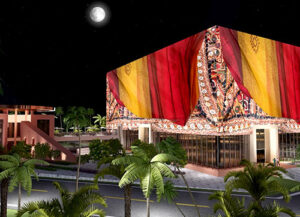
a multifariousness of our country is celebrated
Through the Pavilion, we hope to celebrate the cultural multifariousness of our country whilst nurturing the idea of India as a pool of opportunities for investment and collaboration. As one of the fastest-growing nations in the world, the design of the Pavilion imbibes the theme of ‘India on the move’. The façade comprises 600 individual blocks that move using kinetic architecture. The design also celebrates India’s 75 years of Independence. Through seventy-five identified stories, the façade would engage visitors through the charm of storytelling through the day – familiarizing them with the history, geography, and literature of the country. In the evening, the façade will turn into a vibrant show with sound, light, and projections, almost as if hosting a festival.
The pavilion is the tallest at the Expo. We used sustainability as one of the key design features, integrating climatological influences of the region with technology. Movement in the façade helps control factors such as sunlight and wind inside the pavilion which is helpful in regulation of natural daylight and ventilation.

Tell us about some innovative technologies and materials that you have used on facades?
Through our designs, the aim is to lead architecture as an amalgamation of creativity and engineering. The building envelopes in India International Convention Centre, Dwarka, New Delhi, are designed to communicate an image of contemporaneity inspired by tradition. A thoughtful skin system is proposed to achieve sustainability, as well as synthesize each facet of the project, such as materiality, constructability, and budget. It is mainly focused on performance and constructive optimization. All façades are proposed to be layered in two orders. The first one will be a regular system, attending to all static conditions and the other is the structural system, which will be optimized to be integrated into the building structure. One of the most talked-about design features includes the crowning of the Convention Centre with, what is poised to be the world’s largest, LED video wall. The video wall is specially engineered for the project. LEDs will be accessible from behind, and grating catwalks would be provided for ease of maintenance.

Façade of the Gomti Nagar Railway Station Redevelopment is a bespoke amalgamation of the grandness of Awadhi architecture. The jaali adorning the face of the complex spans the entire length, punctuated by a pattern that seems timeless in appearance. It is complemented by the introduction of arches in the skin while accommodating it as the structural element to the outer face of the terminal. Taking inspiration from the traditional domes, the roofs take a curvilinear shape, also lining photovoltaic cells upon it.
The glass and glazing industry has gone through a major change over the past 15 years. What are your observations?

The glas\s and glazing industry has undergone a tremendous metamorphosis over the last decade and a half. From simply being a material that was looked at for consistency in quality, today is incorporating various techniques and technologies pertaining to its sustainability factors. Technologies that support environmental design, allow the envelope to be far better controlled, and also assess the constructability have transformed the material from its initial stage. The glazing industry is also incorporating factors such as daylight control in its mechanism which empowers the buildings to be climatologically responsive.
With digital projections and 3D mapping, the façade can communicate with its visitors. Additional features such as self-cleaning glass, etc. are useful for promoting innovation. The future that I see for the industry is that it incorporates as much technology as well as drive forward with sustainability.
Convincing a client regarding certain design features is not an easy task. How do you go about it?
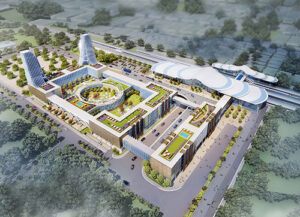
Not getting classified into a single silo of a certain kind of building or a certain kind of client, we believe, that architecture cannot be restrictive in that sense and that we should be able to deal with all situations, all projects, all sites, and all kinds of clients. Accordingly, we have consistently worked, both, in the private sector and on Government projects. Both kinds of situations bring their challenges and their pros and cons.
My personal experience has been that a client is willing to listen, provided we have the conviction and ability to be able to convey to them, our design ideas and thoughts. Once that is done, I think the experience can turn out to be very positive.
What’re your views on the future facades?
India seems to be witnessing exciting times with the plethora of opportunities waiting to be explored in its design and development sectors. The availability of large development areas like new cities, towns, etc. makes the scope for growth through green practices an achievable feat. The way forward is to definitely integrate technology with design – making facades kinetic so they can respond to their surroundings will amplify the sustainability factor of a building.
Additionally, this also is the perfect time to be learning through the design and development practices already implemented across the world and customizing and formulating them to suit the country’s requirements for us to benefit best out of them. The public today is deeply engaged with topics that concern the overall urban development, influence of design on the mental wellbeing of the citizens.
